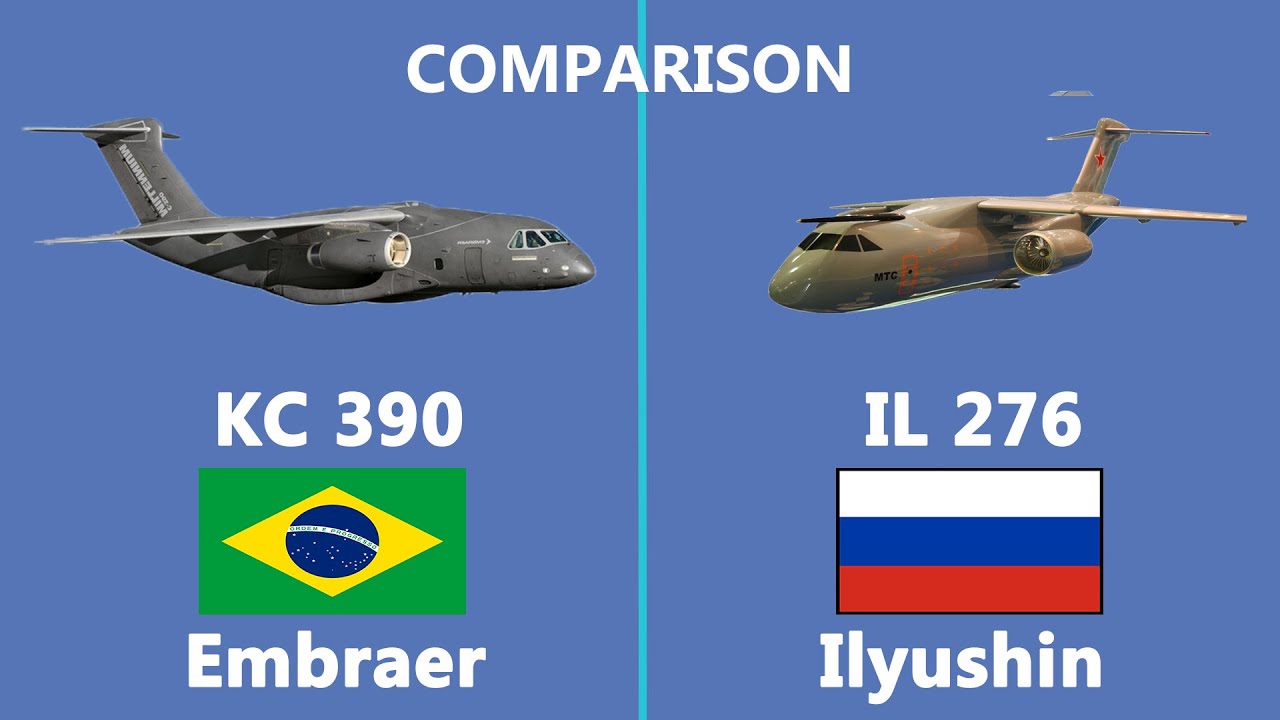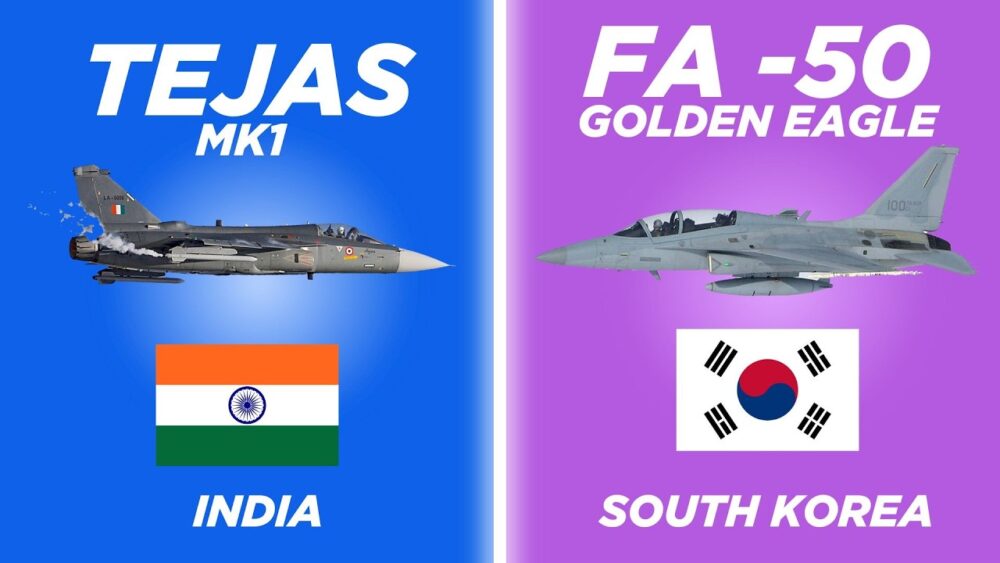Aircraft comparison
Comparison of the Brazil’s Embraer KC-390 Vs Russian Ilyushin Il-276 cargo plane

Two cargo planes that look almost similar are now in the race for military aircraft contracts, One is built in Russia which is Ilyushin Il-276 and the other is a Brazilian-built KC 390 both are in the same category of aircraft with varied features and capacities. In this article, we will explore more about these aircraft.
IL 276
The Ilyushin Il-276 is a medium-lift military transport aircraft that is being developed by the Russian aircraft manufacturer Ilyushin Aviation Complex. It is intended to replace the aging fleet of Soviet-era An-12 and An-26 transport planes and will be capable of carrying up to 20 tons of cargo or up to 90 troops.
The Il-276 is designed to operate in a wide range of conditions, including hot and high-altitude environments, and will feature modern avionics and engines for improved efficiency and reliability. It is expected to have a range of up to 7,500 kilometers (4,660 miles) and a maximum speed of around 800 kilometers per hour (500 mph).
Development of the Il-276 began in 2016, and the first flight is expected to take place in 2023, with production beginning in 2025. The aircraft will be marketed both domestically and internationally and is expected to be used by the Russian military as well as by other countries in need of a reliable medium-lift transport plane.
KC 390
The Embraer KC-390 is a medium-sized military transport aircraft developed by the Brazilian aerospace company Embraer. It is designed to perform a variety of missions, including transport and airdrop of troops and cargo, air-to-air refueling, search and rescue, medical evacuation, and firefighting.
The KC-390 is powered by two International Aero Engines V2500-E5 turbofan engines and has a maximum takeoff weight of 81,500 kilograms (179,700 pounds). It can carry up to 26 metric tons (57,000 pounds) of cargo, or up to 80 fully-equipped troops, and has a range of up to 2,730 nautical miles (5,056 kilometers) with a full payload.
Aircraft comparison KC-390 vs Kawasaki C-2:Read more
The aircraft has a modern cockpit with advanced avionics and fly-by-wire controls, which enhance safety and reduce pilot workload. It also has a self-defense system, including a radar warning receiver, a missile warning system, and chaff and flare dispensers.
The KC-390 made its maiden flight in 2015 and has since entered service with the Brazilian Air Force. It has also been ordered by the Portuguese Air Force and the Hungarian Air Force. The aircraft has been praised for its versatility and cost-effectiveness and is expected to compete with other medium-sized military transport aircraft, such as the Lockheed Martin C-130J and the Airbus A400M.
Features
Ilyushin has a length of 123 feet and a wingspan of 35.5 metres, whereas the KC 390 has a length of 115 feet and a wingspan of 35.05 metres. Moreover, the KC-390 has a ferry range of up to 8,500 km, whereas the Il-276 has a range of up to 7,500 km.
Comparison Between Embraer Kc-390 and Airbus A400M:Read more
The Il-276 is powered by two Aviadvigatel PD-14M turbofan engines, which are currently under development. And KC-390 is powered by two International Aero Engines (IAE) V2500-E5 turbofan engines. which is a popular choice for military transport aircraft, as well as commercial airliners, and is known for its high reliability, fuel efficiency, and low maintenance costs.
Ilyushin can carry up to 70 to 150 passengers by enlarging the fuselage, KC-390 depends on the configuration and seating arrangement chosen by the operator. In a typical troop transport configuration, it can carry up to 80 troops.
The Il-276 aircraft is still in development. However, some estimates suggest that the aircraft will have a maximum speed of around 870 km/h. Kc-390 is a transport aircraft, it is designed to operate at high speeds, and has a speed of 988 km/h.
As can be seen, both aircraft are competing for the Indian military aircraft order deal. Some of the Indian military’s aircraft are currently out of date due to the fleet’s age and the changing needs for capacity.

Aircraft comparison
Comparison of the Indian built Tejas MK1A vs South korean FA 50

Today, we’ll explore two remarkable light combat aircraft: the Tejas MK1A and the FA-50 Golden Eagle. Both fighters are designed for versatility, making them ideal for various missions, from air-to-air combat to ground support.
The Tejas MK1A, developed by Hindustan Aeronautics Limited (HAL) in India, and the FA-50, a product of Korea Aerospace Industries (KAI), are both advanced aircraft equipped with modern technology and features.
10 Fascinating Facts About India’s AMCA Fighter Jet
In this Article, we will compare these two fighters in terms of their specifications, performance, capabilities, and roles in modern air forces. Let’s dive in and see how they stack up against each other!
Tejas is the second supersonic combat aircraft developed by Hindustan Aeronautics Limited (HAL), following the HF-24 Marut. It took its first flight in 2001 and was inducted into service with the Indian Air Force (IAF) in 2015. Currently, Tejas holds the distinction of being the smallest and lightest aircraft in its class of supersonic combat jets.
On the other hand, the FA-50 is South Korea’s first indigenous supersonic aircraft and is one of the few supersonic trainers in the world. Development of the T-50 began in the late 1990s, with its maiden flight taking place in 2002.
Russia Seeks Talks with India, Offers Tu-160 Bombers at Unbeatable Prices
The FA-50 boasts a higher production rate compared to the Tejas. Over the past 15 years, Korea Aerospace Industries (KAI) has produced nearly 200 variants of the FA-50, while Tejas has seen a lower production output.
In terms of international sales, the FA-50 is actively in service with multiple countries, including Indonesia, Iraq, the Philippines, Thailand, and Poland. Notably, Malaysia opted for the FA-50 over the Tejas, citing the FA-50’s strong service record as a key factor in their decision.
Here’s a SPECIFICATION of the Tejas and FA-50
Length: The Tejas measures 13.2 m (43 ft 4 in), making it slightly longer than the FA-50, which is 13.14 m (43 ft 1 in).
Max Takeoff Weight: The Tejas has a maximum takeoff weight of 13,500 kg (29,762 lb), compared to the FA-50’s lighter weight of 10,722 kg (23,638 lb).
Fuel Capacity: The Tejas has an internal fuel capacity of 3,060 liters (810 US gallons), while the FA-50 has a slightly lower internal fuel capacity of 2,655 liters (701 US gallons).
Powerplant: Both aircraft are powered by General Electric F404 turbofan engines, but the Tejas utilizes the F404-GE-IN20 variant with 48.9 kN (11,000 lbf) thrust dry and 85 kN (19,000 lbf) with afterburner. The FA-50 features the F404-GE-102 variant, producing 53.07 kN (11,930 lbf) thrust dry and 78.7 kN (17,700 lbf) with afterburner.
Maximum Speed: The Tejas has a maximum speed of 2,220 km/h (Mach 1.8), which is significantly faster than the FA-50’s maximum speed of 1,837.5 km/h (Mach 1.5).
Combat Range: The Tejas has a combat range of 739 km (459 mi), whereas the FA-50 has a much longer range of 1,851 km (1,150 mi).
Hardpoints: The Tejas features 9 hardpoints with a total capacity of 5,300 kg, while the FA-50 has 7 hardpoints capable of carrying up to 5,400 kg of payload.
Cost: The Tejas is priced at approximately $40 million per unit, whereas the FA-50 ranges between $30 million to $40 million per unit, making the FA-50 potentially more cost-effective depending on the variant chosen.
Weapons
When it comes to weaponry, the Tejas MK1A offers a wider range of options compared to the FA-50 Golden Eagle. The Tejas MK1A is equipped with beyond-visual-range (BVR) missiles, allowing it to engage targets at greater distances, enhancing its combat effectiveness in air superiority missions. Additionally, it can carry precision-guided munitions for accurate strikes against ground targets, as well as standoff weapons, which can be launched from a distance to minimize exposure to enemy defenses. This diverse armament enables the Tejas to perform a variety of roles, from air-to-air combat to ground support.
In contrast, the FA-50 also features a respectable armament capability but has a more limited selection. It can carry air-to-air missiles like the AIM-9 Sidewinder and AIM-120 AMRAAM, as well as precision-guided bombs. However, its focus leans more toward close air support and light strike missions rather than the extensive versatility that the Tejas offers.
Naval Variant
The Tejas Mk1A has a naval variant designed for carrier operations, which is still in development. This version includes upgrades like a nose droop for better visibility during landings and takeoffs, a strengthened undercarriage, and an arrestor hook for safe landings on aircraft carriers.
In contrast, the FA-50 does not have a naval variant. While it’s versatile for different missions, it’s not designed for carrier operations, limiting its flexibility compared to the naval Tejas, which can operate from both land and carriers.
-

 Aviation2 months ago
Aviation2 months agoMicrosoft Flight Simulator Raises $3 Million to Bring Back the An-225 Mriya
-

 Airlines2 months ago
Airlines2 months agoQatar Citizens Can Travel to the United States Without a Visa
-

 Aviation2 months ago
Aviation2 months agoQatar Airways bans these new Electronic Devices on plane
-

 Airlines2 months ago
Airlines2 months agoJapan Airlines Rolls Out Free Domestic Flights to International Passengers
-

 Travel2 months ago
Travel2 months agoQatar Airways Launches Four Additional Flights from Amsterdam
-

 Defence2 months ago
Defence2 months agoWhich Country Has the Largest Fleet of Fighter Aircraft?
-

 Airport2 months ago
Airport2 months agoWestern Sydney Airport Welcomes Its First Plane After 6 Years of construction
-

 Airlines4 days ago
Airlines4 days agoDAMAC Air: Dubai’s New Luxury Airline Offers Free Flights for Registration








